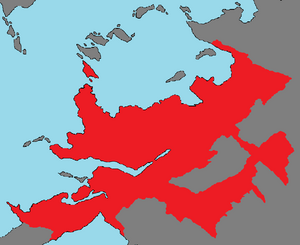Catica First Nations: Difference between revisions
(Created page with "{{Infobox country |native_name = |conventional_long_name = Catica First Nations |common_name = |image_flag = |alt_flag...") |
No edit summary |
||
| (One intermediate revision by the same user not shown) | |||
| Line 7: | Line 7: | ||
|national_motto = | |national_motto = | ||
|national_anthem = | |national_anthem = | ||
|image_map = | |image_map = 042_Conrad_Cichorius,_Die_Reliefs_der_Traianssäule,_Tafel_XLII.jpg | ||
|alt_map = | |alt_map = | ||
|map_caption = A | |map_caption = A relief panel from the 1700-year-old groundstone of the [[Congressional Hall Capitol Building]] in [[Tofino]] depicts the building of a [[Kelownan Peoples|Kelownan]] fort | ||
|capital = | |capital = | ||
|official_languages = | |official_languages = | ||
| Line 92: | Line 92: | ||
}} | }} | ||
The '''Catica First Nations''' are indigenous peoples of the | The '''Catica First Nations''' are indigenous peoples of the Western [[Euronia]] who are composed of many nations and tribal affiliations, each with distinctive cultural and political identities, but they share certain beliefs, traditions and practices, such as the centrality of animals as a resource and spiritual symbol, and many cultivation and subsistence practices. There are 129 recognized First Nations governments or bands spread across Zamastan, roughly half of which are in the provinces of [[Zian]], [[Jade]], and [[Pahl]]. Some nations within this conglomerate posessed large territorial holdings and created large cities. The city of [[Tofino]], for example, was constructed and inhabited by the [[Kelownan Peoples]]. The Catica Empire, which existed from 300 AD to 1480 AD, was the result of massive military campaigns and diplomatic annexations across Western Zamah St'an. | ||
==History== | |||
[[File:TheCaticaEmpireAtHeight.png|thumb|right|The Catica Empire at its height in 700 AD]] | |||
===Catica Empire=== | |||
==List of tribes== | ==List of tribes== | ||
The Western | The Western Euronia Coast at one time had the most densely populated areas of indigenous people ever recorded in Zamastan. The land and waters provided rich natural resources through cedar and fish, and highly structured cultures developed from relatively dense populations. Within the west, many different nations developed, each with their own distinct history, culture, and society. Some cultures in this region were very similar and share certain elements, such as the importance of fish to their cultures, while others differed. Prior to contact, and for a brief time after colonization, some of these groups regularly conducted war against each other through raids and attacks. Through warfare they gathered captives for slavery. | ||
===Kelowna=== | ===Kelowna=== | ||
Revision as of 01:13, 22 May 2020
Catica First Nations | |
|---|---|
 A relief panel from the 1700-year-old groundstone of the Congressional Hall Capitol Building in Tofino depicts the building of a Kelownan fort |
The Catica First Nations are indigenous peoples of the Western Euronia who are composed of many nations and tribal affiliations, each with distinctive cultural and political identities, but they share certain beliefs, traditions and practices, such as the centrality of animals as a resource and spiritual symbol, and many cultivation and subsistence practices. There are 129 recognized First Nations governments or bands spread across Zamastan, roughly half of which are in the provinces of Zian, Jade, and Pahl. Some nations within this conglomerate posessed large territorial holdings and created large cities. The city of Tofino, for example, was constructed and inhabited by the Kelownan Peoples. The Catica Empire, which existed from 300 AD to 1480 AD, was the result of massive military campaigns and diplomatic annexations across Western Zamah St'an.
History
Catica Empire
List of tribes
The Western Euronia Coast at one time had the most densely populated areas of indigenous people ever recorded in Zamastan. The land and waters provided rich natural resources through cedar and fish, and highly structured cultures developed from relatively dense populations. Within the west, many different nations developed, each with their own distinct history, culture, and society. Some cultures in this region were very similar and share certain elements, such as the importance of fish to their cultures, while others differed. Prior to contact, and for a brief time after colonization, some of these groups regularly conducted war against each other through raids and attacks. Through warfare they gathered captives for slavery.
Kelowna
The Kelownan Peoples were once one of the most powerful and populous groups of tribes on the southern part of the Zamastan Coast. Their territories flank the mouth of the Phelan River and stretch up that river in a narrow band adjacent to that river, as far as what is now known as Gillead's Falls. Their group of dialects are known as Kelownan. It is distinguished from the Kelowna Jargon, which was partly based upon it, and is often called "Kelowna." Close allies of the Nuu-chah-nulth peoples, they are also a canoe people, and pre-Armillio contact, Kelowna Jargon arose as a trading language incorporating both Chinookan and Wakashan vocabulary. The Kelownan peoples practiced slavery, likely learned from the Nuu-chah-nulth as it was more common to the north, and cranial deformation. Those without flattened heads were considered to be beneath or servile to those who had undergone the procedure as infants.
One likely reason for the cultural prominence of the Kelowna peoples was their strategic position along the Phelan River, which acted as a massive trade corridor, as well as near Gillead's Falls, the longest continuously-inhabited site in Zamastan, used as a fishing site and trading hub for 15,000 years by a wide range of indigenous peoples.
